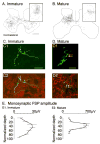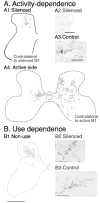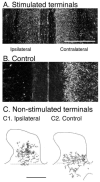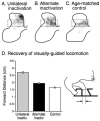Activity- and use-dependent plasticity of the developing corticospinal system
- PMID: 17599407
- PMCID: PMC2769920
- DOI: 10.1016/j.neubiorev.2007.04.017
Activity- and use-dependent plasticity of the developing corticospinal system
Abstract
The corticospinal (CS) system, critical for controlling skilled movements, develops during the late prenatal and early postnatal periods in all species examined. In the cat, there is a sequence of development of the mature pattern of terminations of CS tract axons in the spinal gray matter, followed by motor map development of the primary motor cortex. Skilled limb movements begin to be expressed as the map develops. Development of the proper connections between CS axons and spinal neurons in cats depends on CS neural activity and motor behavioral experience during a critical postnatal period. Reversible CS inactivation or preventing limb use produces an aberrant distribution of CS axon terminations and impairs visually guided movements. This altered pattern of CS connections after inactivation in cats resembles the aberrant pattern of motor responses evoked by transcranial magnetic stimulation in hemiplegic cerebral palsy patients. Left untreated in the cat, these impairments do not resolve. We have found that activity-dependent processes can be harnessed in cats to reestablish normal CS connections and function. This finding suggests that aspects of normal CS connectivity and function might some day be restored in hemiplegic cerebral palsy.
Figures





References
-
- Alisky JM, Swink TD, Tolbert DL. The postnatal spatial and temporal development of corticospinal projections in cats. Exp Brain Res. 1992;88:265–276. - PubMed
-
- Arlotta P, Molyneaux BJ, Chen J, Inoue J, Kominami R, Macklis JD. Neuronal subtype-specific genes that control corticospinal motor neuron development in vivo. Neuron. 2005;45:207–221. - PubMed
-
- Armand J, Kuypers HGJM. Cells of origin of crossed and uncrossed corticospinal fibers in the cat. A quantitative horseradish peroxidase study. Exp Brain Res. 1980;40:23–34. - PubMed
-
- Baldissera F, Hultborn H, Illert M. Integration in spinal neuronal systems. In: Brooks VB, editor. Handbook of Physiology, Section I: The Nervous System, Vol II, Motor Control. American Physiological Society; Bethesda: 1981. pp. 509–596.
Publication types
MeSH terms
Grants and funding
LinkOut - more resources
Full Text Sources
Miscellaneous

